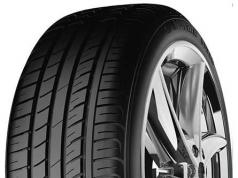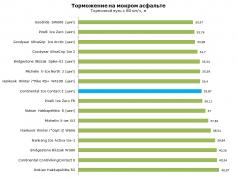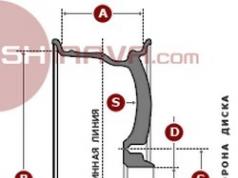Rotation frequency crankshaft when the torque converter is locked below normal when the selector lever is in the "D" or "R" position. If the engine speed at which the torque converter locks up is below normal, then the reason for this may be a lack of engine power or a malfunction of the torque converter. Check engine for misfiring mixture, valve tightness and serviceability piston group(see "Checking the compression in the cylinders", p. 78). If the engine is in good working order, then the torque converter is faulty.
If the performed check reveals a malfunction automatic box gear, contact a specialized car service to repair it.
engine stalled while driving
Sooner or later, each driver may find himself in a situation where a car, a few moments ago, obeying all commands, suddenly stops responding to pressing the gas pedal, and dashboard red lights come on. The engine stops working and the vehicle loses speed. What to do in such a situation?
Most importantly, don't be nervous! Turn on the hazard lights, depress the clutch pedal if the vehicle is equipped mechanical box and, using the vehicle's inertia, try to move carefully to the edge of the carriageway and stop as far to the right as possible at the side of the road, and if possible outside the carriageway.
A WARNING
Please note that when idle engine efficiency brake system the vehicle is reduced and more brake pedal force may be required to brake. The same thing happens with the power steering.
Turn on parking brake; if the vehicle comes to a stop on a slope, use wheel chocks... At difficult conditions traffic and on country roads put up an emergency stop sign, as provided by the Rules road traffic... Now it is necessary to identify and eliminate the problem that has arisen.
There are two main reasons:
The ignition system does not work;
The power system does not work.
First, find out if there is gas in the tank. Switch on the ignition and look at the fuel gauge. If the yellow reserve remaining fuel lamp does not light up, and the pointer arrow indicates the presence of fuel, it can be assumed that there is gasoline in the tank.
Open the hood and inspect carefully engine compartment... Pay attention to the integrity of all units. Check if all wires are in place, if there are any broken, burnt, or damaged insulation. Os-
check the petrol hoses, fuel rail for leaks of petrol.
A WARNING
If gasoline leaks, under no circumstances start the engine until the malfunction is completely eliminated!
Inspect expansion tank cooling systems - coolant leaked. Also check the oil level in the engine crankcase. If everything is in order, proceed with the check of the ignition and power systems, which is described earlier, but before that check the condition of the timing belt. If the belt is torn, the engine will not start for no apparent reason.
In addition, a sudden stop of the engine and the impossibility of subsequent start-up can cause the failure of the crankshaft position sensor or the disconnection of the harness block from it.
fell
Your vehicle's instrument cluster has a warning light for an emergency engine oil pressure drop. For the engine to operate reliably, a sufficiently high pressure must be maintained in the engine lubrication system at all times.
A WARNING
If the oil pressure drop warning light comes on while the engine is running and remains on at increased engine speed, this is an alarm. Stop driving immediately, stop the engine and find out the reason. Further operation of the engine at low oil pressure can lead to serious damage and high financial costs for repairs.
Checking the lubrication system
1. Open the hood. Do not rush to immediately check the engine oil level, let it drain into the oil sump, it will take two to three minutes. During this time, carefully inspect the engine and find out if there are any fresh oil leaks on it.

2. Look under the front of the car to see if the engine oil sump is punctured or leaks.
HELPFUL ADVICE
If you find an oil leak from a punctured oil sump, try to temporarily repair it in place. To do this, you can use a car camera, a piece of rubber, a rag, a wooden cork, etc. Good result can give the use of modern repair materials such as "cold welding", available for sale in car dealerships.
3. Pay attention to oil filter... Oil may leak from under rubber pad filter if it is damaged or the filter is loose. Sometimes it is enough to turn it clockwise a little.
A WARNING
Hot engine parts can burn you, so wear gloves and long sleeves.

4. Take out oil dipstick, wipe it with a clean cloth and reinsert. Remove the dipstick again and check the oil level. It should be between the top and bottom marks.
5. If the oil level is less than the lower mark, add oil to the normal level.
HELPFUL ADVICE
If there is no funnel for adding oil, you can use a funnel made from a plastic bottle.

b. Start up the engine. If at normal level, the emergency pressure drop lamp
See also:
As with most cars over the age of 5 years, in the Mitsubishi Lancer 9, certain problems may appear during operation. The most significant of these are engine-related malfunctions. Let's look at the main engine problems.
The check signal on the dashboard came on
Almost any problem with the engine is indicated on the dashboard of the Mitsubishi Lancer 9 in the form of the "CHECK ENGINE" icon.
This indication indicates that there is an error in the engine control system, and it should be checked using diagnostic devices, then the error should be eliminated.
Car engine errors are classified as active, that is, active, and inactive (which have accumulated during the operation of the car, but are not currently relevant).
Inactive engine errors can be deleted in a simple way on one's own. To do this, you must remove one of the terminals battery for 15-20 minutes. After that, all errors from the engine control unit will be erased. At the moment the ignition is switched on again, the check will only indicate if there are still valid errors in the control system. Such an indication may not appear immediately, but after several tens (and even hundreds) of kilometers. Usually such "pop-up" errors are associated with the catalyst system, temperature sensors.
If, after self-deleting errors, the check lights up again, the reasons for this may be different. To eliminate errors, computer diagnostics are required. This can be done at a service station or independently if you have any simple OBDII diagnostic scanner, including Bluetooth ELM327 using a smartphone. After determining the error code, its decryption is performed and the indicated malfunction is eliminated.
Engine won't start
Such a malfunction is critical when the operation of the car becomes impossible. Often manifests itself in frost. When troubleshooting this problem, refer to the following table 1.
| Malfunction | Possible reasons | |
|---|---|---|
| The dashboard does not light up when the ignition is turned on | The battery is discharged, one of the main fuses has failed | Check battery voltage, fuses |
| Indicators on the dashboard turn on, when the engine starts, the starter does not work, the lights on the dashboard dim | The battery is discharged, poor contacts of the battery terminals, poor "earth" of the engine, the starter is faulty | Check the voltage on the battery, clean the contacts of the battery terminals, the "earth" of the engine. Execute renovation work starter. |
| When starting the engine, the starter motor rotates the crankshaft, the engine will not start | Faulty fuses serving the engine control unit, main relay, fuel pump relay, fuel pump failure, crankshaft sensor, flow meter. | Check fuses, relays, fuel pump, run computer diagnostics, replace faulty components |
| The engine grasps during the start, but does not start | Insufficient performance of the gasoline pump, failure of spark plugs, ignition coils, clogging fuel filter | Check the fuel pump, spark plugs, ignition coil, rail pressure |
| Engine starts and stalls | Malfunction of the immobilizer system, low fuel pressure in the rail | Check the pressure in the rail, replace the fuel pump if necessary. Diagnose the immobilizer system |
The engine starts, but is unstable, the speed is floating
When eliminating this malfunction, you should be guided by the recommendations given in table 2.
| Malfunction | Possible reasons | Troubleshooting Sequence |
|---|---|---|
| Idling speed float | Failure of one or more injectors, spark plugs, regulator malfunction idle move, sensor mass flow air | Checking the flow meter using computer diagnostics, checking the injectors at the stand, cleaning the injectors, replacing the spark plugs |
| At low speeds, the engine is unstable, it can suddenly stall | Failure of the flow meter, clogging of the fuel system, low performance of the fuel pump, malfunction of the idle speed regulator, suction in the air intake system | Computer diagnostics of the engine, replacement of faulty sensors and regulator XX, elimination of a possible place for air leaks |
| Jumping engine speed while driving in normal mode | Malfunction fuel pump, fuel system, clogged fuel filter, fuel pump filter, faulty wiring to the fuel pump. Wear of candles. Ignition coil defective | Verify fuel system car, wiring to the fuel pump, ignition coils. Replace candles |
Other common problems with Mitsubishi Lancer cars 9
In cars Mitsubishi Lancer 9 with a high degree of probability, the following "diseases" are manifested:
- Sensitivity to fuel quality. This is, in principle, common to all Japanese cars. In some cases, when refueling the 9th Lancer with 98th gasoline, engine overheating is observed.
- Increased fuel consumption. Most experts associate this fact with catalyst fouling. Even computer diagnostics does not detect a malfunction in this system, catalyst wear causes a significant increase in fuel consumption. On a car with an engine capacity of 1600 cc, it can be over 15 l / 100 km. Also, such a consumption can be a consequence of the wear of the lambda sensor.
- Moisture penetration into the connectors. This problem causes corrosion of the contacts and in turn can lead to malfunctions of electrical equipment and control systems, including the engine. For the prevention of contacts, you can inject into the contact area of the connectors special tool(can silicone grease in the form of a spray). The grease displaces water from the contact area, preventing corrosion.
Hello dear users of the site site. A story came up with me here. After replacing the battery idle speed began to fall on my Lancer 9 (or rather, not after replacement, but after my Lancer stood without a battery for about a day).
At the same time, the revolutions fell so that during the factory it was necessary to press the gas pedal so that the car did not stall. Those. Lancer went deaf immediately after the plant. I had to read a lot, a lot of information on the Internet, and now I am sharing with you.
According to information on the Internet, there can be two reasons for the fact that the revs are low, and the car sometimes even starts to stall.
Reason 1 (and the easiest to solve). The fact that the Lancer has reduced revs are to blame for the "brains" of the car. They need to be retrained, or rather to teach idle.
I found three ways on the internet idle learning Lancer 9... I will say right away that the third method helped me, the other two were not crowned with success, and the turnover was still reduced.
Method 1. This method is taken from the Lancer manual. As I said, it did not help me, but you must try it (the picture is clickable):
Method 2. Found it on the Internet:
- We warm up the car until working temperature
- We reset the terminal for about a minute.
- We put the terminal back on.
- Turn off all consumers (turn off the air conditioner, stove, headlights, radio) and start the car for 10 minutes (no load)
- We turn off the ignition and start again, but turn on the load to the maximum (heating, air conditioning, high beam etc.) for 10 minutes.
- We jam the car - the training is over.
Method 3. I was already desperate, to bring the idle speed in order, fortunately I came across this way, he helped me:
- We remove the terminal from the battery for 10-15 minutes (the positive terminal or the negative terminal does not matter).
- We put the terminal back on (after 10-15 minutes).
- We start the car, let it run for exactly 10 minutes at idle speed, MANDATORY all loads are turned off (i.e. the lights, stove, air conditioner, radio, etc. are turned off). I had about 2000 rpm in this mode.
- We jam the car, pause for 10 seconds, start again.
- We are waiting for the engine to warm up to operating temperature and look at the rpm - if we got up to 750-800, that's great. After that, I went on business and my turnover did not fall.
- In the next 100-150 kilometers, everything should be normalized.
Reason 2 (already more complicated, and sometimes more expensive). For this reason, the removal of the battery only coincided with the main reason for the fall idle speed... The idle speed regulator (IAC) is to blame, while it can be trivially covered (and it needs to be changed), or, you just need to clean it. In more detail, about what I dug up about IAC on our Lancer 9, and how to maintain it, I will try to tell you in the next article.







